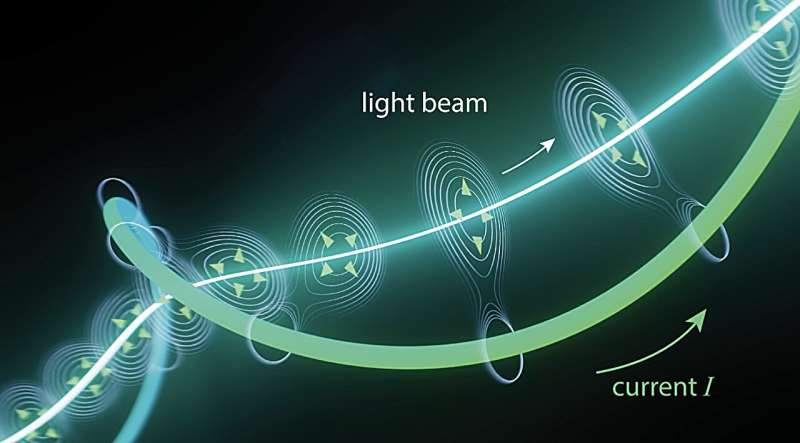Reliably guiding and capturing optical waves is central to the functioning of assorted up to date applied sciences, together with communication and data processing programs. Probably the most typical method to information mild waves leverages the overall inside reflection of optical fibers and different related constructions, but lately physicists have been exploring the potential of methods based mostly on different bodily mechanisms.
Researchers at College of Southern California lately devised a extremely revolutionary method for trapping mild. This methodology, launched in Nature Physics, exploits the unique properties of Lagrange factors, the identical equilibrium factors that govern the orbits of primordial celestial our bodies, corresponding to so-called Trojan asteroids within the sun-Jupiter system.
“The invention of Lagrange factors, which occurs to be pivotal on this analysis, will be traced again to the early work of Leonhard Euler and Joseph-Louis Lagrange, which discovered that at these areas, the gravitational attraction exerted by two giant our bodies will be exactly counterbalanced by centrifugal forces,” Mercedeh Khajavikhan and Demetrios N. Christodoulides, co-authors of the paper, informed Phys.org.
“Whereas a few of these factors, notably and, are already employed as strategic positions in area for satellite tv for pc stability with minimal propellant consumption (as exemplified by the James Webb telescope and the lately deployed Aditya L1 satellite tv for pc), our research focuses on the intriguing properties of and Lagrange factors.”
Trojan asteroids are a big group of asteroids circling the solar on the identical orbit because the planet Jupiter. Lagrange factors, named after the famend mathematician Lagrange who uncovered them, are positions in area wherein the gravitational drive of two our bodies in the identical system (e.g., the solar and Jupiter) produce enhanced areas of attraction and repulsion.
As a part of their research, Khajavikhan and Christodoulides got down to examine the potential of using the distinctive physics of those positions to information and lure mild waves. Of their paper, the researchers confirmed that using and Lagrange factors for optical purposes in some methods resembles capturing Trojan asteroids throughout the sun-Jupiter orbit.
“The Lagrange optical waveguide is induced by passing present by means of a helical wire in a cured silicon oil cylinder,” Khajavikhan and Christodoulides mentioned.
“By the use of the thermo-optic impact, this in flip produces a twisted index panorama the place on this case, the photon repulsion is balanced by the centrifugal drive. Counterintuitively, on this mountain-slope index profile, a steady Lagrange level, is produced and because of this, a Trojan optical beam is trapped in a two-dimensional style at this place.”
As a part of their research, Khajavikhan and Christodoulides created a compact system of their laboratory reproducing the properties of Lagrange factors, corresponding to these noticed within the orbits of Trojan asteroids. Their laboratory-built system was comprised of a helically-shaped iron wire inserted in a medium with a temperature-dependent refractive index.

The researchers might later warmth this medium in a non-homogeneous means by passing electrical energy by means of the wire. Finally, this course of enabled the formation of what they check with as a Trojan optical beam.
This straightforward experiment led to very attention-grabbing observations. Curiously, the researchers discovered that optical Trojan beams may very well be guided or captured on this defocusing refractive index setting, one thing that’s not possible beneath regular circumstances.
“Extra importantly, the refractive index panorama the place these optical beams are captured is totally unremarkable, having no options in anyway that might foretell a guiding response,” Khajavikhan and Christodoulides mentioned. “In essence, the optical beam is trapped in a nowhere land—in utterly inconspicuous areas the place no typical waveguide constructions exist.”
The latest work by this staff of researchers reveals the distinctive traits of Lagrange factors will be leveraged to information and lure mild waves. Sooner or later, it might type the event of latest methods to information optical waves in unconventional environments when typical approaches are ineffective, corresponding to in liquids and gases.
“A potential avenue for additional exploration may very well be using Trojan beams in amplifying (laser) programs, the place optical achieve or loss can set up different means for beam attraction or repulsion in totally dielectric media,” Khajavikhan and Christodoulides mentioned.
To this point, the researchers have solely centered on using Lagrange factors for guiding mild beams. Nevertheless, sooner or later the methodology they developed is also examined in different areas of physics reaching past optics, as an illustration as a method to information acoustic waves or ultracold atoms.
“At this level, we plan to discover the opportunity of guiding mild in acoustic waves in each liquid and gaseous media,” Khajavikhan and Christodoulides added. “Lastly, of curiosity can be to watch for the first-time trapping and transporting dielectric micro- and nano-particles in Lagrange waveguides utilizing optical tractor beams the place a number of Lagrange factors will be induced—a facet that’s not potential in celestial mechanics.”
Extra data:
Haokun Luo et al, Guiding Trojan mild beams by way of Lagrange factors, Nature Physics (2024). DOI: 10.1038/s41567-023-02270-6
© 2024 Science X Community
Quotation:
A Trojan method to information and lure mild beams by way of Lagrange factors (2024, January 30)
retrieved 30 January 2024
from
This doc is topic to copyright. Aside from any honest dealing for the aim of personal research or analysis, no
half could also be reproduced with out the written permission. The content material is supplied for data functions solely.




